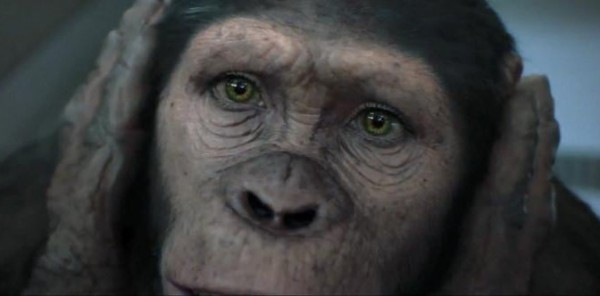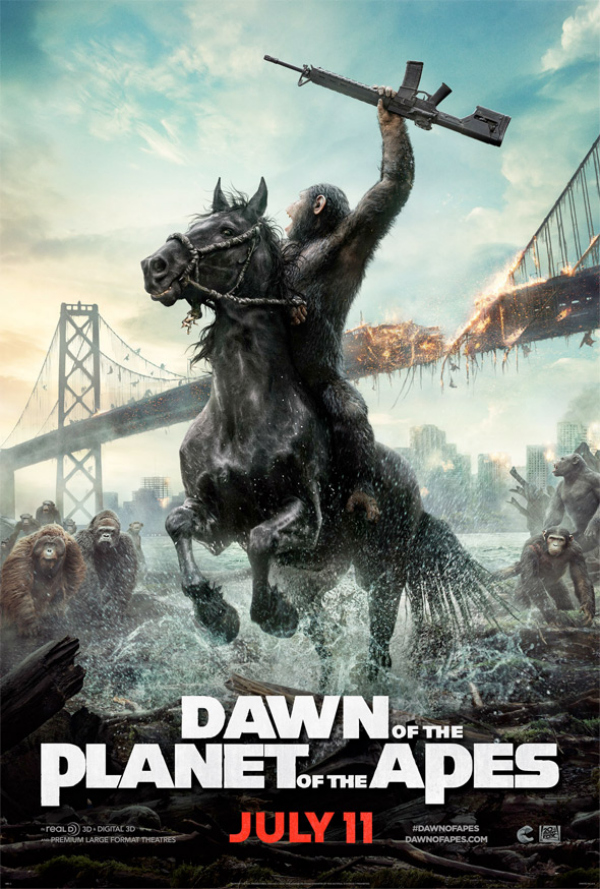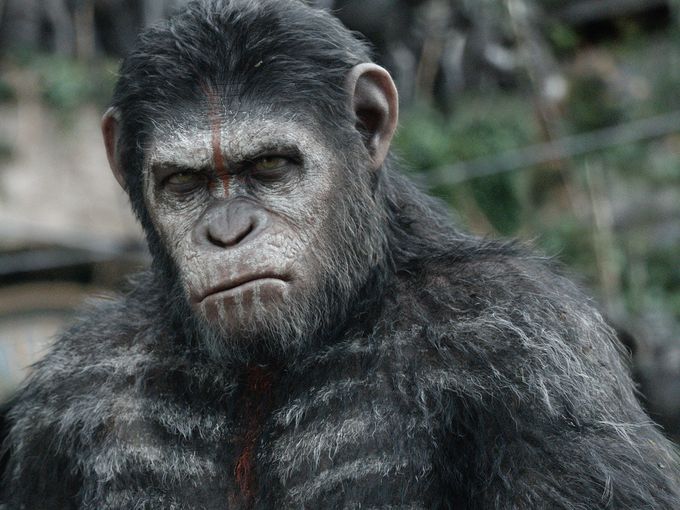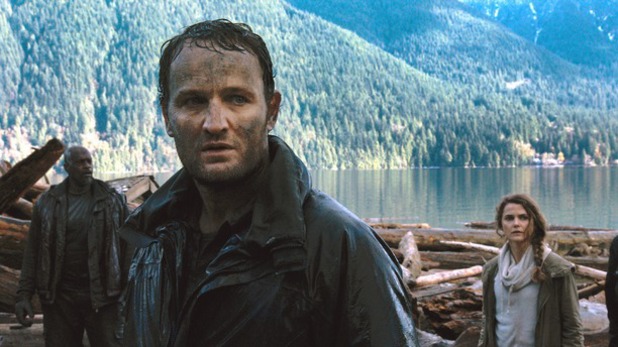Written by Andé Morgan.
Dawn of the Planet of the Apes (2014) is an artful and visually appealing summer blockbuster, and it almost makes up for Transformers: Age of Extinction (2014). Unfortunately, like that movie and almost every other recent film in its genre, Dawn has a dearth of significant female characters.
Dawn was directed by Matt Reeves and written by Mark Bomback, Rick Jaffa and Amanda Silver. It is the sequel to Rise of the Planet of the Apes (2011).
Featuring much less James Franco (thank you, Noodly One) than Rise, Dawn stars Andy-Serkis-in-a-digital-monkey-suit as Caesar, Gary Oldman as Dreyfuss, leader of the surviving humans, and Jason Clarke as Malcolm, an utterly unmemorable white male lead. Keri Russell plays Ellie, a former CDC doctor and Malcolm’s companion.
The introductory news montage dovetails with the end of Rise. The Simian Flu, unleashed by Franco’s character, has killed almost everybody. A clutch of genetically-immune humans has outlasted the violent first 10 years of the apocalypse. Like characters in a late ’70s sitcom, they’re scraping by and doing the best they can in the bottom of a San Francisco high-rise.
In contrast the apes, led into the Muir Woods by Caesar in the previous film, have built a cellulose utopia. No cages, no electricity, no artisanal cat videos, no bullshit. Reeves and company do an excellent job of establishing a believable community, and of illustrating the depth of the inter-ape relationships. The father-son drama between Caesar and Blue Eyes is particularly well done, both in movement and in dialogue (such as it is), and was my favorite element of the film.
Malcolm and Ellie form a post-apocolyptic nuclear family with Malcolm’s son, Alexander (Kodi Smit-McPhee). Malcolm leads them and a small group of stock characters into the Muir Woods to locate and renovate a hydroelectric dam so that the survivors can power their peripherals. This quest precipitates the inevitable confrontation between the humans and the apes.
Did I mention less James Franco? Also, the visual elements were excellent. Filming took place on Vancouver Island, British Columbia, and Reeves and Michael Seresin (cinematographer) really sell the lush rain forests of the Pacific Northwest. The scenery works well with the CGI and motion capture techniques, and the scenes where Caesar and family hunt and fish are beautiful and seamless.
If only the humans could have been apes. I know the film was really about the apes, anyway, but it was hard to identify with the human characters enough to care about their fate. Speaking of humans and unsympathetic characters, Gary Oldman was woefully miscast as a former military special operations badass. Judging by his stilted and unenthusiastic delivery, he wasn’t sure what he doing there, either.
Also, dystopia, again. I know, the whole series is about the fruits of war and hubris, but I’m just feeling saturated. Lately, it seems like every wide release can’t wait to tell me about how humanity is so over. What’s more, the dystopia in Dawn is not dystopic enough (if it sounds like I’m complaining out of both sides of mouth, I am). It’s too shiny, and the humans are too happy and well fed. The survivors’ colony looks more like a saturday morning farmers’ market than the last remnant of humanity. Post-tribuation San Fransico actually looks more livable covered in vegetation and sans traffic.
Similarly, the ape community is shown as a bit too idyllic (at first, anyway), and initially conveyed a subtle look-at-the-happy-natives vibe.
The movie so badly wanted to be taken seriously, but the score did not help. It alternated between ineffective back ground movie muzak and hokey homage to the cheesiest riffs of the original films. The film was best in its dark moments, and it should’ve gone darker instead of relying on poorly-aged instrumentals and noble savage tropes.
As Kyle Buchanan notes, Dawn’s dystopia is similar to its contemporaries in one important way: women need not apply. Of the many female survivors depicted, only Ellie has any lines. Almost all of which constitute her comments on or validation of the acts of Malcolm and Alexander. For example, Sam Adams references a scene where Ellie marks Malcolm’s development by saying, “That was a brave thing you did.” What little we see of her trails off to nothing in the third act as Malcolm goes adventuring solo, as a man should, apparently.
The Muir Woods don’t fare any better. It’s a bit more difficult to tell, but I reckon that the only female ape shown on screen was Caesar’s spouse, Cornelia (Judy Greer). We meet her as she gives birth (it’s a boy!) in the first act. She spends almost the entire remainder of the film in the same place, suffering and shivering from an infection contracted during the birth. As a device designed to humanize Caesar and to foster a bond between the survivors and the apes, I guess she works. As a well developed, depthful character, not so much. In fact, no one even addresses her directly — you won’t even know her name unless you stay for the credits.
Maurice, a male orangutan and Caesar’s confidant, was played by female actor Karin Konoval (she also played Mrs. Peacock in the infamous X-Files episode Home). Unlike the other male apes, Maurice doesn’t seem particularly conflict-oriented. While he acknowledges that his experience as a circus ape exposed him to the bad side of humanity, he seems to understand Caesar’s sympathy for the survivors. In one of the best scenes of the film, Alexander looks up from reading a graphic novel in his tent to see an observant Maurice quietly sitting outside. He goes to Maurice, and they read together.
Dawn was sorely missing a strong female character. How much more interesting the story would have been if Ellie had taken the lead in negotiating with Caesar and getting the dam up and running! Similarly, a fighting female ape could have provided interesting contrast while either avoiding or spotlighting appearance-based tropes about violent women.
Some critics have posited that Dawn’s lack of female characters was justified due to the film’s supposed focus on “primal urges.” Primal usually means essential or original, but apparently primal means violent when we’re talking about hominids. And women, and stereotypically feminine values like empathy and non-violence, just aren’t primal. Except that they are. Indeed, even modern male apes aren’t universally violent or paternalistic. I wonder, where were the Bonobos?
Regardless, Dawn isn’t about primal urges. Instead, it is about the physical and mental frailty of humankind. Like most other contemporary blockbusters, it reflects our modern anxieties, including our feelings of helplessness and discord — feelings held by men and women alike.
Also on Bitch Flicks: Depictions of dystopias in television and film.
Andé Morgan lives in Tucson, Arizona, where they write about film, television, and current events. Follow them @andemorgan.




